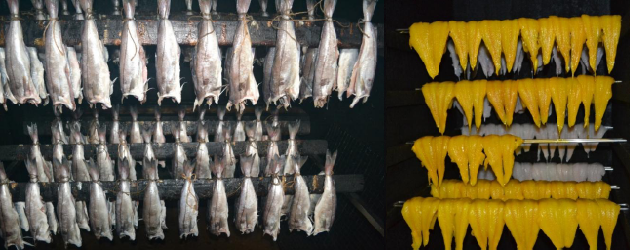This review of current practices in the management of Listeria monocytogenes in the smoked fish sector aimed to develop information for food business operators and local food authorities on the key risk areas from farm to end-product for L. monocytogenes contamination and the monitoring and management of these.
 |
| [relatedPosts title=”Related Posts”] |
Background
A previous study carried out by the Agency (FSIS 05/08) highlighted that cold-smoked fish products are frequently contaminated with low levels of Listeria monocytogenes. Listeria is a ubiquitous environmental pathogen, which is often present on the fish naturally and it can survive well in the moist environments found in fish processing and smoking establishments.
Cold smoking includes no bactericidal step that will remove any contamination with listeria.
Coupled with extended shelf lives, this makes cold-smoked fish a foodstuff that is at particular risk from listeria contamination.
Hot smoked fish products are at risk from subsequent cross-contamination that may occur after the cooking steps. Recent survey work undertaken in the UK by the HPA has shown that smoked fish can be contaminated with L. monocytogenes, albeit rarely, at levels above the statutory limit of 100 CFU/g for ready to eat foods.
Research Approach
The overall objectives of this project were to review current practices in the management of L. monocytogenes used by manufacturers in the smoked fish sector, identify key risk areas in the processing chain (from farm to end-product) and gaps in the management of these, and to disseminate information for food business operators and local food authorities on the key risk areas for L. monocytogenes contamination and the monitoring and management of these.
To achieve this, the project carried out the following:
- a literature review identifying key monitoring and intervention steps applicable in the UK for manufacturers of smoked fish with regard to listeria
- collation of information on industry practices, manufacturers’ attitudes to cleaning and monitoring, packing methods and associated risk management practices utilised by the smoked fish sector
- collation of information on inspection activities and enforcement regimes utilised by local food authorities.
Additionally the study aimed to establish in what format the results of this study would be most accessible to those involved in the management of Listeria in smoked fish products.
Results and findings
The literature has identified key production and processing practices that could potentially influence the prevalence of L. monocytogenes.. A series of visits to fish farms and commercial smokers was also undertaken, along with a survey of environmental health officers.
From the literature it was identified that fish entering processing plants can have listeria present on their skin surfaces, with prevalence rates being low, but variable. It was also identified that some L. monocytogenes biotypes can persistently colonise plant processing environments and these plant resident biotypes are more likely to be isolated from the final products. Specific process stages and regions within smoked fish processing plants appear to be more susceptible to persistent colonisation by L. monocytogenes. Such reservoirs include drains, skinning machines, brine injection units and fish slicers.
Visits to fish farms demonstrated that in Scotland, there is routine and widespread monitoring for listeria on the fish and on-farm equipment and there is understanding of the importance of monitoring the effectiveness of cleaning. Visits to commercial fish processing and smoking premises identified that larger throughput plants have well-informed technical staff but that smaller throughput plants did not have ready access to such technical expertise. The industry visits also highlighted that smaller businesses experience difficulties in undertaking shelf life studies.
The survey of environmental health officers identified that their main concerns were related to plant cleaning and sanitation, the control of key hazard microorganisms, product characteristic monitoring, post process handling and shelf life determinations; both in terms of business practices and their own knowledge gaps. The survey also identified that environmental health officers felt there is a lack of understanding regarding HACCP, particularly in smaller businesses.
A number of key recommendations highlighting areas where guidance or additional information would be of benefit to industry and enforcement officials were made.
Further Information
The complete research report is available here (PDF).





